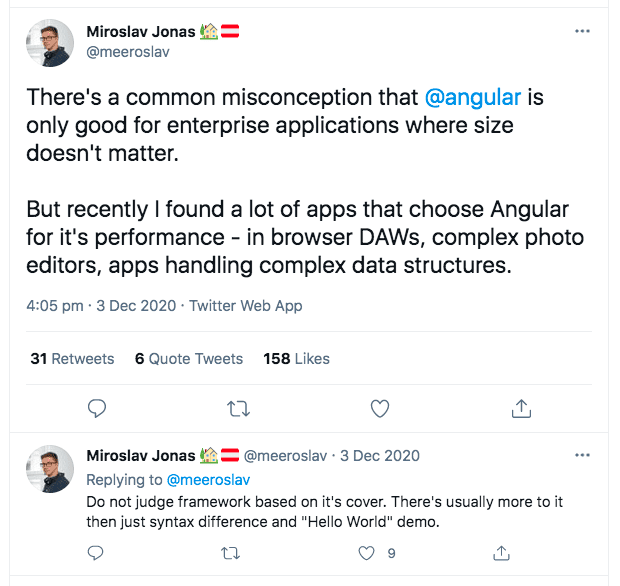Within the competitive market of choosing the best frontend framework for application development, Bootstrap and Angular have come up to the hot-seat. The fundamentals of both the frameworks are different – starting from its architecture, components, development style, testing, code maintainability, and even its learning curve. While on the one hand, Bootstrap is an HTML/CSS/JS framework with ready-made components, Angular is a TypeScript based framework with vast tools and immense codes for app development.
Instead of getting into the competitive debate, you can read through our comprehensive guide outlining the fundamentals of both the frameworks and know their suitability for your next project. If you feel you need a one-to-one outlook and expert opinion, feel free to connect with our web app expert and discuss possibilities for your project with Simform’s frontend development offerings.
What is Bootstrap? – An Overview
Bootstrap, also known as Twitter Bootstrap, is an open-source front-end CSS framework used to create responsive mobile-first websites. The front-end framework template for Bootstrap is primarily based on CSS. It has become a popular UI development framework for its responsive design templates, frameworks, grids, and most importantly, multi-site compatibility.
Mark Otto and Jacob Thornton developed this framework with the idea of standardizing the use of a framework by Twitter employees. This is how the framework came to be known as Twitter Bootstrap. In 2011, the developers launched this project on GitHub for everyone’s access.
Market Usage Statistics
Here are some interesting market usage statistics of Bootstrap:
- As of May 2022, approximately 4.25 million people have downloaded Bootstrap for web development.
- Till May 2022, Bootstrap is used by 21.7% of all websites amongst the JavaScript libraries.
- In terms of popularity and traffic, Bootstrap holds 2nd position with 14.38% of the market share.
Use Cases of Bootstrap
- Microblogging applications
- Social media applications
- Video streaming applications
- E-commerce websites
- Content-based website
- Geo-location applications
- On-demand applications
- Payment applications
- Messaging service web app
- Responsive web applications
Popular Apps Built with Bootstrap
- Vogue – The fashion magazine uses Bootstrap for its flat responsive website templates, making the site compatible with all devices. It also uses Bootstrap’s 12 grid layout to fit in various content-based details within a single screen.
- Apple Maps Connect – Apple uses MapKit JS for creating its interactive maps for multiple platforms. The Mapkit JS employs Bootstrap to build its user interface designs.
- Lyft – The ride-sharing company utilized Bootstrap’s grid features along with the drop-down plugins for their website. The framework also helped in the website’s development within a short span of time.
- Paypal – The online payment processing website uses Bootstrap’s Pricing Sliders to create the payment forms while checking out, adding cards, or paying bills through the site.
- Whatsapp – The user interface of Web Whatsapp has been created using Bootstrap for better interactive features and facilities over the desktop application.
What is Angular? – An Overview
Angular is a typescript-based Javascript framework that helps businesses build scalable web applications. It is a standalone front-end framework with in-built tools and libraries that don’t hamper the size or application speed. It provides development opportunities across all platforms through its reusable code that can be used for any deployment target. It has a dynamic UI binding at plain object or property level, and a two-way data binding that is integral to its architecture.
Angular was initially released in 2016, which was a complete rewrite of the 2010 AngularJS. The application framework was developed by Misko Hevery and the Angular team at Google. It is the same team that is handling the framework today, along with other external developers.
Market Usage Statistics
- Amongst the JavaScript library, we are aware of, Angular is used by 0.4% of all websites.
- While fewer sites use Angular, it is primarily used by high-traffic sites.
- Angular has 79.7k stars, 21k forks, approximately 1600 contributors, and a repository of 1.7 million users on GitHub.
- Angular is used by 22.96% of developers worldwide.
Use Cases of Angular
- Video streaming applications
- eCommerce applications
- Real-time data application
- User-generated content portals
- Content-based websites
- Progressive web applications
- Native mobile applications
- Single page web applications
- Gaming applications
- Cloud-based applications
Popular Apps Built with Angular
- Mixer – The live streaming platform for video games incorporated Angular to create the interface of its video streaming facilities. It also helped the team to update data of single-page applications in real-time.
- Gmail – The single-page mailing application uses Angular for its dynamic interface. The site renders data on the front-end, enables access to the cached data offline, and incorporates several SPA advantages.
- PayPal – The online payment processing website incorporated Angular to carry out stunning website performance and easily handle spikes in user transactions. Its few-clicks authorization and the checkout page are some of the other features built with the help of Angular.
- Forbes – The digital edition of the American magazine uses Angular 5 for its user interface, which has the capability to respond to 74 million monthly users in the US.
- Weather.com – The Weather Channel incorporates Angular for its UI that is managed by separate teams for its separate directories. Angular allows the site to integrate multiple maps, real-time broadcasting, and video streaming for news updates.
Bootstrap vs. Angular – Pros and Cons
Before you choose a framework, it’s important that you understand the opportunities and shortcomings it brings along. This comparison between Bootstrap and Angular should help you select the most compatible technology for your application.
Pros of Bootstrap
- Responsive design – Provides the necessary features of creating a user interface that is responsive in styles and structures and is compatible with multiple platforms.
- Time-saving – Provides excellent documentation on each component, and its readily available resources help omit the process of writing codes and debug the sites quickly. The CSS preprocessor, LESS, can be used to save time on the custom development process.
- Styling Components – Provides various user templates, themes, and plugins and a grid system that are free and customizable as per project requirements.
- Consistency and Compatibility – Excellent CSS and Javascript compatibility enables excellent cross-browser consistency
- Substantial community support – A free and open-source framework available on Github with significant community support contributing to its development.
Cons of Bootstrap
- Similar website templates – Usually criticized for having limited templates, making websites and applications made with Bootstrap look the same. Avoiding this similarity might require extensive manual customization which can be time-consuming and beats the purpose of using this framework.
- Learning curve – Developers may have to invest some time, though depending on their prior knowledge of frontend technologies, to learn more about the class components and combinations.
- Rewriting and Overriding – Significant amount of customization might lead to deviation from the customary Bootstrap designs, creating compatibility and consistency issues.
Pros of Angular
- Advantage of TypeScript – The superset for JavaScript offers superior navigation, refactoring services, and autocomplete, eliminating errors within code while developing enterprise-scale applications.
- Google Support – Long-term Google support backed with detailed documentation and further possibilities of expanding the framework with improved developmental features.
- High Performance – Provides high performance to the developers ensured by the hierarchical dependency injection, Ivy renderer, AOT compiler, differential loading, and Angular Universal support.
- Recommendation of Updates – Angular command-line interface provides time-to-time recommendations required for dependencies, loaders, and plugins.
- Third-party Integrations – The framework allows easy integration of third-party applications, providing more flexibility and tools for the development progress.
- Customizable Framework – Elements and modules can be easily integrated from other frameworks and customized as per the developer’s requirements. Reusing and managing Angular HTML elements is also possible by wrapping them as a DOM element.
Cons of Angular
- Complexity – Despite its component-based architecture, the management of components and repetitiveness make the frontend framework verbose for its development community.
- Angular Versions – Migrating from AngularJS to Angular is a huge hassle for the developers, even more, when the framework application is vast. Moreover, learning about each version makes the learning curve steeper and decreases its popularity.
- Heavily weighted framework – Simple and small applications can become bloated because of their requirements of boilerplate codes, abstractions, and other bundled features.
Want to read more of frontend comparisons?
Know about Angular vs Vue
Bootstrap vs. Angular – Performance Comparison
While performance should not be a killer factor for small projects, it becomes extremely important to consider when building complex and large projects. With that being said, let’s compare Bootstrap and Angular in terms of performance.
How does Bootstrap stand out in terms of performance?
Bootstrap is known for its user-centric ease for developing websites and web applications, but when it comes to performance, one has to keep a close eye on it. Developers have often criticized the framework for its vast library and unutilized resources, leading to slower performance. But, what they miss is that it also offers extensive customization features to increase the app’s performance, irrespective of it being content-heavy.
Utilizing requirement-specific resources reduces the bulk over the website, such as using the source code rather than the entire library. Minimal and lean use of CSS and JavaScript codes minimizes the load on the downloading browser and increases efficiency while displaying. Other common workarounds would include compressing images, moving the server closer to the audience, and using a CDN for a high-performance loaded website. With the best practices, Bootstrap can have a lower fully loading time of 2.1 seconds of a page size that is 1.3 MB.
How does Angular stand out in terms of performance?

When it comes to high-performance frameworks, Angular has proved itself for facilitating superior performance. The framework is powered by Ivy renderer, which is a rewrite of Angular’s rendering engine. It promises to make the applications super quick and compact for unmatched performance and compile components that also reduce its development time.
The advanced change detection mechanism and ahead-of-time compilation reduces the number of times DOM manipulates, pre-compiled HTML, and app components before the browser downloads and uses them. This might be the reason behind the much-gained popularity as a Javascript framework for building high-performing apps.
Bootstrap vs. Angular – Application Architecture
When choosing a framework, it’s important to choose flexibility and avoid any strict enforcement of architecture and guidelines. As a matter of fact, it’s always recommended to treat a framework as a guide, not methods and standards. That said, let’s juxtapose Bootstrap and Angular with each other and check whether they are flexible in terms of architecture.
What kind of architecture does Bootstrap support?
Bootstrap’s architecture can be summarized as a View-View-Controller architecture because of its built that uses two components – Logic Layer and the View Layer. The views component focuses explicitly on the visual displays, while the view-controller sets out all the visual components’ behavior within the framework. There are six modules within the view layer, while the logic layer has twelve components that provide unique functionality to a corresponding visual aid.
Bootstrap supports the Model-View-Controller architecture pattern while developing a webpage. But, it is to be noted that while creating a web application using the MVC design principle, the framework would serve as the view component.
What kind of architecture does Angular support?
Angular has a Model-View-Controller architectural pattern that isolates the application logic from the user interface layer and efficiently supports the separation of concerns. The architecture also helps in organizing the code components according to design and performance variations. It also simplifies the development structure by combining the MVC pattern and two-way data binding.
Unlike other web frameworks, which implement two-way data binding by using fragile event listeners and handlers, Angular makes this process an integral function of its architecture. Moreover, given that the framework isolates the business logic from the UI components, developers are more confident in designing a neat user interface with smooth business logic applicable.
Bootstrap vs. Angular – Ease of Testing
To be able to work without a glitch under continuous, high load, and growing market expectations, your application development project needs to go through a series of tests to ensure compliance with the UI standards, compatibility, and usability. Here’s how Bootstrap and Angular stand out when compared with testing.
How easy is it to test a Bootstrap app?
While there are no internal components within Bootstrap for running tests, external plugins and compatible tools can be used for testing apps and sites made with Bootstrap. One advantage that the framework has is that the cross-browser bugs would be eliminated because of its single coding component that is reusable and does not require any repetition.
However, irrespective of this advantage, running tests across browsers from different devices is necessary to check the application’s consistency and uniformity. External applications that can be utilized for testing a bootstrap application include Chrome Developer Tools, DesignModo, BrowserStack, UIlicious, TestComplete, and many more.
How easy is it to test an Angular app?
Testing is an integral part of the Angular framework, and all JavaScript codes in Angular are required to go through a series of tests. The convenience offered in testing allows us to develop the project from scratch and seamlessly test the components.
Thanks to the dependency injection in Angular, it manages all the scopes and controllers. The unit test functionality in Angular can force dependency injection to perform testing by injecting mock/dummy data into the controller. This process is followed by the assessment of the output and its behavior. What’s more interesting is that Angular also has mock HTTP providers to push fake responses from servers into controllers.
Bootstrap vs. Angular – Scalability
Frameworks significantly influence the web application scalability, therefore, the right choice of framework is important. Here’s how Bootstrap and Angular stand out in terms of scalability.
Is Bootstrap scalable?
Being a mobile-first development framework, Bootstrap can be relied on for making scalable websites and applications. Through Bootstrap, responsive website content can be scaled up or down depending on the browser, application, or screen that the user is using. The framework also omits cross-browser bugs and compatibility issues through its single universal codes and makes it preferable amongst developers.
Bootstrap’s class component allows you to specify column sizes based on the screen sizes and alter the content displayed based on the screens. Furthermore, its interactive grid system also allows creating projects that fit the screen sizes over multiple platforms. So, be it a mobile screen, a tablet, or a laptop, there is a uniformity of aesthetics within the application.
Is Angular scalable?

With continuous support from Google and other established corporations, Angular is a complete framework with the capability to create enterprise-level applications. The scalability of the framework is a result of its powerful command-line interface and feature designs.
Grouping folders and modules based on their features and logical units provides a scalable project structure and easily organizes large codes of a complex application. It is also natural for feature components to keep growing for larger applications, and the suitable action is refracting those into smaller components. Alternatives for improving the scalability include designing the page data model with typescript interfaces and creating a single file for all CRUD operations.
Bootstrap vs. Angular – Suitability for Building Complex Applications
Both Bootstrap and Angular offer official documents, guidelines, open-source projects, and third-party libraries and plugins to support developers throughout the development process. Let’s compare how Bootstrap and Angular fare against each other in terms of building complex apps.
Is Bootstrap suitable for building complex apps?
Being amongst the popular HTML/CSS/JS frontend frameworks, Bootstrap easily passes off for developing complex applications. The framework has a broad range of ready-made components, templates, themes, and other resources that can be utilized depending on the project requirements.
Being a mobile-first framework used for creating responsive websites, Bootstrap can also be used for developing applications that support various platforms, devices, and screens, without having to repeat the codes. Bootstrap’s unique 12 column grid system and visual breakpoints facilitate complex web layouts that can be defined using the predefined grid classes based on viewpoint width. This prevents the cluster of overlapping elements and adjusts designs within a frame that sets the right space amongst its rows and columns.
Is Angular suitable for building complex apps?
Angular is still one of the preferred frontend frameworks used to create complex and large enterprise applications. The most well-known single-page applications like Gmail, Forbes, PayPal have made use of the framework’s architecture for developing complex applications. Its features of limitless scalability allow applications to expand without thinking about their size; reusable codes allow development for multiple platforms; and high performance boosts its speed and user experience. No matter how dynamic the application’s interface is, Angular can turn it into gold for its users.
Bootstrap vs. Angular – Security
It’s only the technology or framework that guides the implementation and management of security controls within an organization. So it’s a necessity that they provide standards or best practices to build secure applications. Let’s compare Bootstrap and Angular in terms of security aspects and check how they fare against each other.
How is security handled in Bootstrap?
It is common for frontend frameworks to have security vulnerabilities, and Bootstrap is also amongst the list that is prone to threats. It is mainly prone to XSS vulnerabilities through the data-target attribute, and developers have reported this threat even over the updated versions. Most vulnerability threats are possible in the tooltip or popover data-temple attribute, affix configuration target property, tooltip data-viewport attribute, data container property of tooltip, data-target attribute, and data-target property of scrollspy.
The vulnerability exists within the package because of insufficient validation of user-supplied input. However, there are ways to overcome this threat. Developers can choose to implement a new JavaScript sanitizer to allow whitelisted HTML elements in the data attribute and setting the HttpOnly flag for cookies. Other ways include auditing security reporting workflows, ensuring that they are up to date, and using a Content Security Policy.
How is security handled in Angular?
User-generated websites demand a high level of security and management. Cross-site scripting is one of the significant vulnerabilities that the client-side platform needs protection against. These attacks can be prevented by some built-in provisions that the framework provides.
Since there’s no guarantee that attackers won’t enter malicious code through the property, attribute, or any provided value, Angular treats each value as untrustworthy by default. The framework has introduced inner HTML to display the user-generated content and a built-in sanitizer – DomSanitizer – as a security feature. Other security resources include maintaining updated libraries, updating content security policy in security-reviewed code, and using AOT for compiling HTML templates and components. Therefore, following the best practices along with its internal security features and external tools makes Angular a secured framework.
Check how we revolutionised a $2 billion food industry using AngularJS
Bootstrap vs. Angular – User Experience
User experience is one vital element in choosing the right framework for your project. It aims to provide positive experiences that keep users loyal to the product or brand. Additionally, a meaningful user experience allows you to define customer journeys on your applications that are most conducive to business success.
Bootstrap’s ability to give the best user experience
Twitter Bootstrap was developed as a web responsive frontend framework to render a standardized and best user experience. The framework’s responsive design gives web users, developers, and viewers consistency across all platforms, which would directly increase the trust and value of the application.
For enhancing the user experience to a greater degree, Bootstrap UI HTML Kits like Get Shit Done, Shards Dashboard Lite React, and Stream can be used. Other free Bootstrap XD UI Kits include Adobe XD Bootstrap 4 UI Kit, Adobe XD Bootstrap 4 Grid Template, Take Me, Universal Web UI Kit.
Bootstrap also offers custom form controls to create elegant form layouts. It allows you to create customized and browser-compatible radio buttons and checkboxes, file inputs, select dropdowns, and range inputs.
Angular’s ability to give the best user experience
Angular has emerged as a significant frontend framework in building user interfaces and independently handling the frontend. Since the framework has been divided into components, classes, and segmentations for a clean coding architecture, it manages the users’ interaction through templates. The framework manages the display of data to the users in a sophisticated way. Moreover, the library store is responsible for handling reactivity, and asynchronous programming responsible for making the application responsive to users and their actions.
Providing the template language helps keep the data binding and rendering of HTML on the same page. That means, every time the application page is rendered, the framework interacts with the template syntax and updates the view in no time. Again, keeping no time gap between updating and displaying the information to the users.
Bootstrap vs. Angular – Rapid Development
For projects where low Time to Market (TTM) is essential, it’s imperative to look out whether the framework you choose offers rapid development or not. In our experience, development speed is even more important when your team doesn’t have time to learn a new framework or technology. Having said that, let’s uncover whether Bootstrap and Angular offer rapid development or not.
How does Bootstrap contribute to rapid application development?
The frontend framework is known for quickly developing applications and saves time with the help of its extensive documentation. Being developer-friendly, Bootstrap libraries consist of several class components, making it a framework that doesn’t require coding knowledge to develop an application. You would simply need an understanding of a markup language like HTML and styling basics like CSS preprocessors for implementing Bootstrap in your projects.
The ready-made components, JS plugins, and documented synergy also save time and energy to remember the specifications of each element. Bootstrap’s cross-browser compatibility and consistency reduce the bugs on multiple platforms and aids in upgrading an application within a short span of time.
How does Angular contribute to rapid application development?
What can be more precious for developers to build applications regardless of worrying about huge file sizes? With Angular, developers invest less time and effort, for it lets them reuse codes and streamlining the development process. It brings about more functionality with shorter codes, making it productive for the teams working on back-to-back similar projects.
Angular offers flexibility in coding like no other framework because of its simple design architecture. In terms of flexibility, it allows beginners to get started and make modifications in their application projects seamlessly. Also, Angular handles heavy web applications that are loaded with features and components exceptionally well.
Bootstrap vs. Angular – Application Size
The selection of a framework can have a large impact on the size of an application code. For a large project, the application size should dominate the framework size. Less size is always more in this case. Let’s map out the difference between Bootstrap and Angular in terms of application size.
What is Bootstrap’s application size?
Bootstrap application sizes vary, depending on the content that has been used for its design and presentation. A comprehensive and simple Bootstrap application would have a minimum file size of 49 KB in JavaScript and a CSS file size of 137 KB.
Regardless of the minimum application size, developers would have to be wary of the library packages’ unused components that can bulk up an app. Following the best practices of writing lean HTML and CSS codes, downloading resources from the source code, and minimizing the presentation images would reduce the site’s weight. Bootstrap applications can also be compressed by minifying the JS and CSS codes or using GZIP compression.
What is Angular’s application size?
It is a well-known fact that Angular applications are generally large enterprise-scale applications, so it shouldn’t be a surprise if their size is bigger than expected. Compared to other frontend frameworks and smaller application sizes, medium-sized Angular applications usually range between 250 KB to less than 500 KB. While it is no wonder that larger and complex applications can exceed those figures, one has to resort to using a compiler for compressing the bundle sizes.
Bootstrap vs. Angular – Code Maintainability
A framework should be easier to maintain and adapt. In terms of application development, maintainability means that your developers can easily analyze the code and proceed in fixing errors, thus implementing the correct functionality. That said, let’s analyze how maintainable the code is in the case of Bootstrap and Angular.
How convenient is it to maintain code in Bootstrap apps?
Bootstrap is a UI framework for developing responsive web applications. The class components, utility packages, and template resources are readily available for utilization without writing codes for its development.
The flexibility of class components makes the applications workable for multiple sites and platforms. Thus having a reusable code omits the rewriting process for separate devices. Therefore, the consistency and cross-browser compatibility of the components reduces bugs while developing the application, making it beginner’s friendly for team projects.
How convenient is it to maintain code in Angular apps?
For any strong development environment to be successful, code consistency is the key. Thanks to the Angular CLI and documentation style guide, they both drive consistency at the pioneer level. Its feature of reusable code also speeds up the development process for a project with a tight deadline.
Angular employs the Plain Old Javascript Objects (POJO) Model to make the code structure handy and independent. This way, we can save ourselves from adding complex functions or methods in the programme, eliminating dependencies on external frameworks or plugins.
Bootstrap vs. Angular – Learning Curve
The learning curve can help organizations understand the time frame required for the developers to become proficient in the framework. It is important to choose a framework as organizations can better perceive the situation and foresee whether the developers require training support or time to practice the framework before starting working with it. Let’s find out how Bootstrap and Angular fare against each other in terms of the learning curve.
How good is the learning curve of Bootstrap for developers?
Bootstrap is a developer-friendly framework. It has a little learning curve for developers who are well-versed with HTML and CSS basics. However, it’d be essential to know and acquire oneself with the CSS classes and the Bootstrap components to make the task easy. Also, it utilizes an entirely different approach than other frameworks, i.e., developing mobile-centric applications, and developers may have to adapt to the new style.
Bootstrap’s extensive documentation makes it quick and easy to develop a web application without knowing to code, but customization might require knowledge of HTML and CSS. Being an open-source framework and having a large community of developers means that there are loads of learning guides for you to begin working. Using this framework can be a great place to start for beginners considering its scope as the most popular framework and its utilization for developing web applications.
How good is the learning curve of Angular for developers?
Being a vast and dynamic frontend framework, Angular has a steeper learning curve. Developers may find it challenging to cover numerous topics at first, but it is worth giving time at the initial phase to have a better understanding of its workarounds. For a productive development in the framework, developers have to be confident with Javascript and a few other programming concepts.
For experienced developers, Angular CLI has a gentle learning curve, allowing developers to predict compilation behavior. This advantage makes it possible to generate smooth builds and reduce the iterating efforts that lead to bad code quality in the end. It is advisable to pick tech stacks based on the requirements of your upcoming projects since Angular gives the best solutions to solve the most challenging problems in large-scale applications.
Bootstrap vs. Angular – Hiring Developers
Irrespective of the advantages and disadvantages of Bootstrap and Angular, it is important to identify the team size before you begin the development. This will help you plan and make a decision based on the cost incurred in sourcing or hiring developers who might be a novice or someone who is already well-versed with the framework of your choice.
How convenient is it to hire Bootstrap developers?
Bootstrap has become one of the critical frontend frameworks for web development adopted by startups and even established companies. Considering the popularity and market share of Bootstrap users, it is pretty easy to hire a Bootstrap developer from the developer’s community. On average, the cost of hiring a Bootstrap developer ranges from $30 – $50 per hour. With experience and advanced skills, the hiring cost would increase up to $100 per hour or even more.
How convenient is it to hire Angular developers?
Angular is amongst the most chosen frameworks for developing large-scale enterprise applications, and despite losing its market share, developers are widely available. Depending on the type of project for application development, you can choose to hire beginners with few years of experience or even skilled, experienced developers. The cost of hiring Angular developers ranges from $10 – $150 per hour in the US market. In-house experienced consultants with more than 15 years of experience would cost more than $150 per hour.
Conclusion
Both Bootstrap and Angular are backed up by two corporates and a huge developing community that is continuously assisting in evolving the framework. Irrespective of the limitations of Bootstrap and Angular, both applications are known for creating popular, modern, high-performance, and even large-scale applications for their users. No matter what framework you choose, it sure would not fail you, given that you have made the choice by understanding the technical requirements of your own project.
With all the technical jargon of Bootstrap and Angular, the one question that is primarily on every business developer’s mind right now is,
“Which frontend framework would be an appropriate framework for my project and profitable for my business growth?”
Our short checklist below will help you in making the decision that would be integral for your business.
Choose Bootstrap if –
- You want to create a responsive mobile-first application.
- You want an advantage of ready-made styling components within your framework.
- You have a basic knowledge of HTML, CSS, and JS and want to learn a new framework.
- You are looking for a framework with easy customization and integration opportunities.
- You are looking for a framework with significant community support.
Choose Angular if –
- You want to create an enterprise-grade application without worrying about its size.
- You want a framework with easy workarounds for testing purposes.
- You are looking for a framework is that backed up by developers at Google.
- You want plenty of coding facilities and features to build a complex application without worrying about the development time.
- You are an experienced developer and have advanced knowledge of JavaScript.




